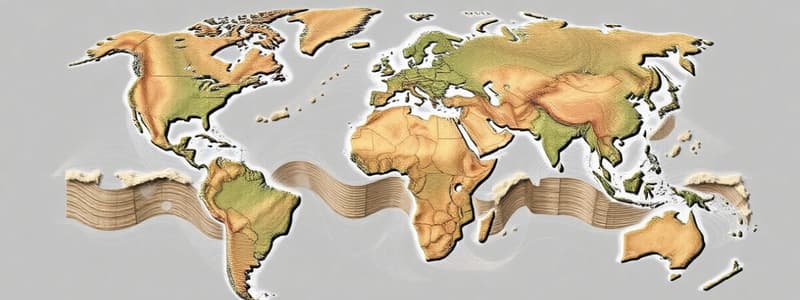Podcast
Questions and Answers
What is one of the key pieces of evidence that supports the Continental Drift Theory?
What is one of the key pieces of evidence that supports the Continental Drift Theory?
- Formation of sedimentary rocks
- Magnetic field variations
- Subduction zone activity
- Topographic evidence of landforms (correct)
Which scientist is credited with the development of the Continental Drift Theory?
Which scientist is credited with the development of the Continental Drift Theory?
- Alfred Lothar Wegener (correct)
- Abraham Ortelius
- Isaac Newton
- Charles Lyell
Identify the type of plate movement characterized by plates moving toward each other.
Identify the type of plate movement characterized by plates moving toward each other.
- Rotational movement
- Transform movement
- Divergent movement
- Convergent movement (correct)
What does the study of paleoclimatic evidence involve?
What does the study of paleoclimatic evidence involve?
Which term describes the giant landmass that existed during the late Paleozoic and early Mesozoic eras?
Which term describes the giant landmass that existed during the late Paleozoic and early Mesozoic eras?
Which type of evidence focuses on the similarities in landforms across different continents?
Which type of evidence focuses on the similarities in landforms across different continents?
What significant concept did Alfred Wegener introduce besides continental drift?
What significant concept did Alfred Wegener introduce besides continental drift?
Which geological process is primarily driven by plate tectonics?
Which geological process is primarily driven by plate tectonics?
Which type of plate movement occurs when tectonic plates slide past one another?
Which type of plate movement occurs when tectonic plates slide past one another?
What type of evidence would involve analyzing ancient climates to support the Continental Drift Theory?
What type of evidence would involve analyzing ancient climates to support the Continental Drift Theory?
Flashcards
Continental Drift Theory
Continental Drift Theory
The idea that continents have moved over geological time.
Plate Tectonics
Plate Tectonics
The fundamental mechanism driving Earth's geological processes.
Convergent Plate Movement
Convergent Plate Movement
Plates moving towards each other.
Divergent Plate Movement
Divergent Plate Movement
Signup and view all the flashcards
Transform Plate Movement
Transform Plate Movement
Signup and view all the flashcards
What evidence supports Continental Drift Theory
What evidence supports Continental Drift Theory
Signup and view all the flashcards
Supercontinent (Pangea)
Supercontinent (Pangea)
Signup and view all the flashcards
Abraham Ortelius' contribution
Abraham Ortelius' contribution
Signup and view all the flashcards
Alfred Wegener's contribution
Alfred Wegener's contribution
Signup and view all the flashcards
Plate Tectonics Mechanism
Plate Tectonics Mechanism
Signup and view all the flashcards
Study Notes
Continental Drift Theory
- Evidence supporting the theory includes topographic evidence, fossil correlation, rock formation, and paleoclimatic evidence
- Abraham Ortelius had speculations about continents drifting
- Alfred Wegener proposed the concept of continental drift in 1912, which was independently developed further.
- Wegener's idea was that continents "drifted"
- The term "supercontinent" was used for a large landmass, also known as Pangea. The Pangea began in the late Paleozoic and continued into the early Mesozoic.
Plate Tectonics
- The fundamental mechanism driving Earth's geological processes is plate tectonics
- Types of plate movement include:
- Convergent: Plates move towards each other
- Divergent: Plates move away from each other
- Transform: Plates slide past each other
Studying That Suits You
Use AI to generate personalized quizzes and flashcards to suit your learning preferences.




